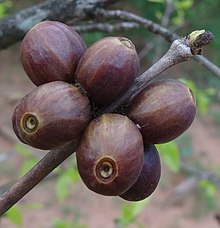| Coffea racemosa | |
|---|---|

| |
| Coffea racemosa berries | |
| Scientific classification | |
| Kingdom: | Plantae |
| Clade: | Tracheophytes |
| Clade: | Angiosperms |
| Clade: | Eudicots |
| Clade: | Asterids |
| Order: | Gentianales |
| Family: | Rubiaceae |
| Genus: | Coffea |
| Species: | C. racemosa
|
| Binomial name | |
| Coffea racemosa Lour. (1790)
| |
| Synonyms | |
|
Cofea ramosa J. J. Roemer & J. A. Schultes (1819) | |
Coffea racemosa, also known as racemosa coffee and Inhambane coffee, is a species of flowering plant in the family Rubiaceae. It has naturally low levels of caffeine, less than half of that found in Coffea arabica, and a quarter of that in Robusta coffee.
Coffea racemosa is endemic to the coastal forest belt between northern KwaZulu-Natal in South Africa and Zimbabwe, found in an area less than 150 km2 (58 sq mi) in size.[2] It was widely cultivated by the Portuguese during the 1960-1970s in Mozambique; currently there are only two plantations, at Ibo Island and in Hluhluwe, which remain.[3]
Coffea racemosa is an open-branched shrub or small tree growing up to 3.5 m (11 ft) tall. It has white to pinkish singular flowers (2 cm (1 in) in diameter) or in few-flowered clusters along the branches, which bloom between September and February.[4] The fruit is near-spherical in shape and purple to black when ripe. The fruit is harvested from the wild for local use as a coffee. The beans are one third of the size of Arabica beans. The beans are roasted and ground to a powder then used to make coffee. Salt is sometimes sprinkled over them as they are roasted.[5][6]
